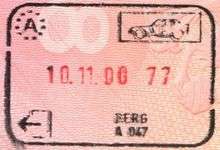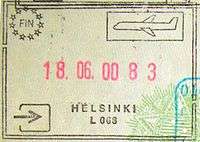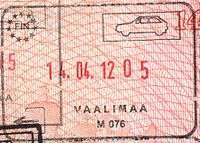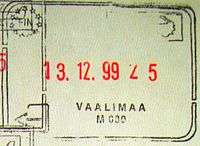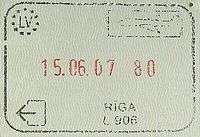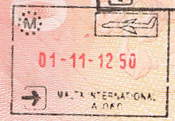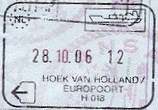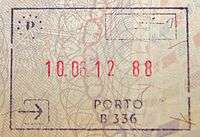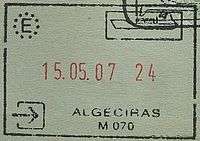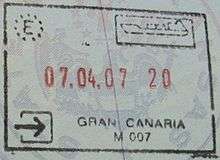Passport stamp

A passport stamp is a rubber stamp inked impression received in one's passport upon entering or exiting a country. Passport stamps may occasionally take the form of sticker stamps, such as entry stamps from Japan. Depending on nationality, a visitor may not receive a stamp (unless specifically requested), such as an EU/EFTA citizen travelling to an EU or EFTA country. Most countries issue exit stamps in addition to entry stamps. A few countries issue only entry stamps, including Australia, Canada, United States, New Zealand, Ireland, and the United Kingdom. Hong Kong, Macau and Israel do not stamp passports upon entry nor exit, but issue landing slips instead. Visas may also take the form of passport stamps.
Use
Immigration authorities usually place stamps in passports at a port of entry or border crossing, as part of their immigration control or customs procedures. This endorsement can serve many different purposes. In the United Kingdom the immigration stamp in the passport includes the formal "leave to enter" granted on entry to the country to a person who is subject to immigration control. Alternatively, the stamps activates and/or acknowledges the continuing leave conferred in the individual's entry clearance. Other authorities, such as those in Schengen Member States, simply stamp a passport with a date stamp that does not indicate any duration and this stamp is taken to mean either that the person is deemed to have permission to remain for three months or an alternative period as shown on their visa. In Japan, the passport entry sticker also contains a QR code that allows the immigration official to electronically collect information related to that entry.
Most countries have different stamps for arrivals and departures to make it easier for officers to quickly identify the movements of the person concerned. The colour of the ink or the style of stamp may also provide such information.
Overview of passport stamps of countries
Asia
Bangladesh
Entry and exit stamps are sealed on passports for all citizens upon arrival at or departure from Bangladesh. Handwritten scroll numbers on the stamp make it easier to track a person's complete journey - a Bangladeshi leaving Bangladesh would receive a scroll number upon exit; upon entry, the scroll number would be used to summon related journey information of the traveler. The same is the case for foreigners, except that the scroll number is given on entry and then used on exit.
The stamps are always in black except the date, which is in red. The stamps contain an arrow exiting a door to denote departure or an arrow entering a door for arrival on the top left corner, and the image of the mode of transportation on the top right corner.
Rectangular stamps for entry and oval stamps for exit make it visually easier to trace movements.
 Entry and exit stamps at Hazrat Shahjalal International Airport on a Bangladeshi passport.
Entry and exit stamps at Hazrat Shahjalal International Airport on a Bangladeshi passport.- Bangladeshi visa in a U.S. passport.
Cambodia
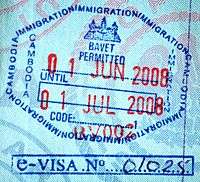 Entry stamp at Bavet land border crossing on the Cambodia-Vietnam border.
Entry stamp at Bavet land border crossing on the Cambodia-Vietnam border. Pre-sticker visas together with older type of passport stamps at Siem Reap airport.
Pre-sticker visas together with older type of passport stamps at Siem Reap airport.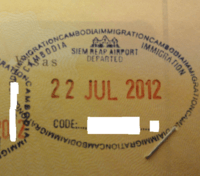 Exit stamp issued at Siem Reap International Airport
Exit stamp issued at Siem Reap International Airport
China
 Entry stamp at Chengdu Shuangliu International Airport in an old People's Republic of China passport.
Entry stamp at Chengdu Shuangliu International Airport in an old People's Republic of China passport. Entry and exit stamps at Dongguan in an old People's Republic of China passport.
Entry and exit stamps at Dongguan in an old People's Republic of China passport.
(Noted that there were no English on stamps.) Entry and exit stamps at Fuzhou Changle International Airport in an old Thai passport.
Entry and exit stamps at Fuzhou Changle International Airport in an old Thai passport. Entry and exit stamps at Guangzhou Baiyun International Airport in a Thai passport.
Entry and exit stamps at Guangzhou Baiyun International Airport in a Thai passport. Entry and exit stamps at Shanghai Pudong International Airport.
Entry and exit stamps at Shanghai Pudong International Airport. Entry and exit stamps at Beijing Capital International Airport in a Republic of Korea passport.
Entry and exit stamps at Beijing Capital International Airport in a Republic of Korea passport.
Hong Kong
The Hong Kong Immigration Department used to stamp the passports of visitors entering and leaving Hong Kong (residents using their Hong Kong Identity Card did not receive a stamp). Just prior to and after the 1997 transfer of sovereignty from the UK to the People's Republic of China, arrival and departure stamps were identical at all ports of entry.
For the next 15 years or so, the ink colour of the stamp differentiated the administrative division of the point of entry:
- Stamps issued within New Territories (Sha Tau Kok Control Point, Man Kam To Control Point, Lo Wu Control Point, Lok Ma Chau Control Point, Lok Ma Chau Spur Line Control Point and Shenzhen Bay Control Point by land, Tuen Mun Ferry Terminal Control Point by sea) are in red ink.
- Stamps issued within Kowloon (Hung Hom Control Point by trains, Ocean Terminal Control Point and China Ferry Terminal Control Point by sea) are in green ink.
- Stamps issued within Hong Kong Island (Hong Kong-Macau Ferry Terminal Control Point, by either sea or air) are in purple ink.
- Stamps issued within Islands District (Hong Kong International Airport Control Point by air) are in black ink.
Beginning 19 March 2013, landing slips are issued to visitors on arrival in Hong Kong instead of passport stamps, and on departure from Hong Kong no slips or passport stamps are issued (being unable to present the landing slip on departure does not affect a traveller's ability to clear immigration). However, in exceptional circumstances, stamps may still be applied.[1]
 Entry stamp at Hong Kong China Ferry Terminal in a Thai passport.
Entry stamp at Hong Kong China Ferry Terminal in a Thai passport.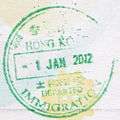 Exit stamp at Hong Kong China Ferry Terminal in a Thai passport.
Exit stamp at Hong Kong China Ferry Terminal in a Thai passport. Entry and exit stamps at Hong Kong International Airport and the Hong Kong – Macau Ferry Terminal in a U.S. passport.
Entry and exit stamps at Hong Kong International Airport and the Hong Kong – Macau Ferry Terminal in a U.S. passport. Old style entry and exit stamps at Hong Kong International Airport and Lo Wu Control Point in an old Thai passport.
Old style entry and exit stamps at Hong Kong International Airport and Lo Wu Control Point in an old Thai passport.
(Noted that there were no Bauhinia on stamps and exit stamps were in oval.)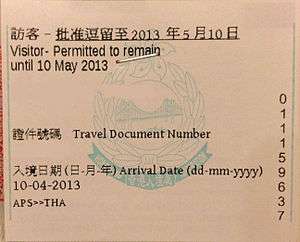 Landing slip since March 2013
Landing slip since March 2013
India
India uses the differentiation in passport stamp colours - entry in blue, exit in red - to quickly trace a passenger's movements. The stamp can be rectangular, circular or oval.
- Entry stamp in an Indian passport at Delhi Airport.
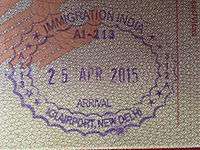 Entry stamp issued to a citizen of Germany at Delhi airport
Entry stamp issued to a citizen of Germany at Delhi airport- Exit stamp in an Indian passport at Delhi Airport.
- Exit stamp in an Indian passport at Delhi Airport.
- Exit stamp in an Indian passport at Delhi Airport.
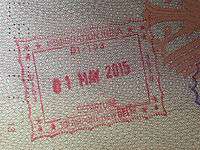 Exit stamp issued to a citizen of Germany at Delhi airport
Exit stamp issued to a citizen of Germany at Delhi airport
Indonesia
- Entry and exit stamps at Ngurah Rai International Airport and Juanda International Airport in a Thai passport.
Israel
Traveling with passports containing Israeli entry/exit stamps to certain Arab nations may lead to a denial of entry, because of the Arab League boycott of Israel. Since January 2013, Israel no longer stamps foreign passports at Ben Gurion Airport, give a piece of paper instead. Passports are still (as of February 2013) stamped at Erez when travelling into and out of Gaza. Also, the passports are still stamped (as of February 2014) at the Jordan Valley/Sheikh Hussein and Yitzhak Rabin/Arava land borders with Jordan.
 An Israeli entry stamp in a U.S. passport at Ben Gurion Airport.
An Israeli entry stamp in a U.S. passport at Ben Gurion Airport..jpg) Entry and exit stamps in a German passport at Ben Gurion Airport (entry: right; exit: left).
Entry and exit stamps in a German passport at Ben Gurion Airport (entry: right; exit: left).
Japan
 Temporary visitor landing permission sticker and exit stamp at Fukuoka Airport in a Thai passport.
Temporary visitor landing permission sticker and exit stamp at Fukuoka Airport in a Thai passport. Temporary visitor landing permission sticker and exit stamp at Haneda Airport in a Thai passport.
Temporary visitor landing permission sticker and exit stamp at Haneda Airport in a Thai passport. Temporary visitor landing permission sticker and exit stamp at Kansai International Airport in a Thai passport.
Temporary visitor landing permission sticker and exit stamp at Kansai International Airport in a Thai passport. Temporary visitor landing permission sticker and exit stamp at New Chitose Airport in a Thai passport.
Temporary visitor landing permission sticker and exit stamp at New Chitose Airport in a Thai passport.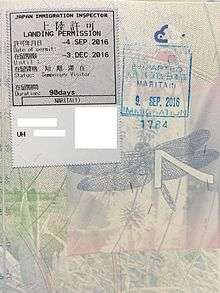 Temporary visitor landing permission sticker and exit stamp at Narita Airport in a British National (Overseas) passport.
Temporary visitor landing permission sticker and exit stamp at Narita Airport in a British National (Overseas) passport. Temporary visitor landing permission sticker at Chubu Centrair International Airport and exit stamp at Fukuoka Airport in a Republic of Korea passport.
Temporary visitor landing permission sticker at Chubu Centrair International Airport and exit stamp at Fukuoka Airport in a Republic of Korea passport. Return stamp at Haneda airport in a Japanese passport.
Return stamp at Haneda airport in a Japanese passport. Departure and re-entry stamps for a foreign resident of Japan in a British passport.
Departure and re-entry stamps for a foreign resident of Japan in a British passport.
Jordan
- Aqaba Special Economic Zone Authority visa in a U.S. passport.
- Entry stamp in a U.S. passport at Wadi Araba Crossing.
- Exit stamp in an Israeli passport at Wadi Araba Crossing.
Laos
- Entry and exit stamps at the Thai–Lao Friendship Bridge.
Macau
Immigration stamps applied by Macau's immigration service under Portuguese administration had slightly different borders depending on whether the person arrived by land, sea, or air. After the transfer of sovereignty from Portugal to China in 1999, passport stamps naming the points of entry and departure were introduced, but all in the same ink color. Beginning of 9 July 2013, the Public Security Police Force of Macau no longer stamps passport and instead, visitors will receive a printed arrival card instead.[2]
 Arrival Card replacing existent passport stamps.
Arrival Card replacing existent passport stamps. Former entry stamp at Macau International Airport.
Former entry stamp at Macau International Airport. Former entry and exit stamps at Outer Harbour Ferry Terminal, Macau.
Former entry and exit stamps at Outer Harbour Ferry Terminal, Macau. Former entry and exit stamps at Taipa Temporary Ferry Terminal in a Philippine passport.
Former entry and exit stamps at Taipa Temporary Ferry Terminal in a Philippine passport.
Malaysia
Malaysian immigration authorities apply stamps for both entry and exit in all foreign passports and non-biometric Malaysian passports without in-built microchips. Biometric Malaysian passports are usually not stamped as all movements in and out of the country are recorded electronically in the microchip.
Malaysian entry stamps for non-citizens and non-residents are rectangular and stamped in blue or black. They bear the date of entry, point of entry and terms of entry. Entry stamps for residents are also stamped in blue ink but have an oval shape and bear the date and point of entry. Exit stamps are triangular and stamped in red. They bear the date and point of departure.
A peculiarity is the autonomy of the Malaysian states of Sabah and Sarawak in immigration affairs. Foreigners who travel to the two states from Peninsular Malaysia are required to fill in immigration forms and get new stamps on their passports. There is also immigration control for travel between Sabah and Sarawak. Previously, Malaysian citizens from the Peninsular were required to present their passports and have them stamped as well; while they are currently still subjected to immigration control, passports are no longer required for social visits not more than three months.
Between 1998 and 2011, foreigners who entered Malaysia via train from Singapore were cleared electronically without their passports being stamped.[3] The change was due to the dispute between Malaysia and Singapore regarding Malaysian-owned railway land in Singapore. The Malaysian railway operator, Keretapi Tanah Melayu (KTM) had its intercity rail southern terminus at Tanjong Pagar railway station in downtown Singapore, which also housed the border controls of both Malaysia and Singapore for rail passengers before 1998. In 1998, Singapore moved its immigration checkpoint northward to Woodlands Train Checkpoint near the actual Malaysia-Singapore border but Malaysia refused to move its checkpoint, resulting in the anomaly that passengers travelling towards Malaysia were granted entry to Malaysia before passing through Singapore exit controls. Instead of passport stamps, foreigners were given disembarkation cards stamped with "KTM Tg Pagar, Singapura" and the date of entry, which would be collected upon departure from Malaysia and a handwritten note indicating the entry would be endorsed in the passport along with the exit stamp. Passengers travelling to Singapore were not affected as Malaysian exit controls were carried out on board trains at the Johor Bahru railway station, where immigration officers endorsed passports by stamping or handwriting. The anomaly was resolved on 1 July 2011, when Tanjong Pagar railway station was closed and Woodlands Train Checkpoint became the railway terminus in Singapore with co-location of border control facilities of both countries. Foreigners entering Malaysia by rail have their passports checked and stamped by Malaysian immigration officers at Woodlands Train Checkpoint after clearing Singapore exit controls.
- Entry stamp into Sarawak at Merapok checkpoint on the Sabah-Sarawak border, with written date for limit of stay.
- Entry stamp for citizens before biometric passports were introduced. This is at former Subang International Airport.
- Standard exit stamp, at Johor Bahru exit to Singapore.
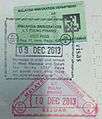 Entry and exit stamps at Penang International Airport in a Thai passport.
Entry and exit stamps at Penang International Airport in a Thai passport.
Myanmar
With the introduction of e-visas, entry stamps into Myanmar at the airports of Yangon, Mandalay and Naypyidaw, the only three entry checkpoints where e-visas are allowed, have been modified to indicate such method of entry.
 Entry (left) and exit stamps issued at the Yangon International Airport. The entry stamp is for people using e-visas. E-visas are issued via letter prior to arrival and are shown to the immigration officer, and not stuck to passports like conventional visas.
Entry (left) and exit stamps issued at the Yangon International Airport. The entry stamp is for people using e-visas. E-visas are issued via letter prior to arrival and are shown to the immigration officer, and not stuck to passports like conventional visas.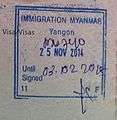 Entry stamp at Yangon International Airport for entries using conventional visas. The visas are stickers stuck on another page of the passport.
Entry stamp at Yangon International Airport for entries using conventional visas. The visas are stickers stuck on another page of the passport.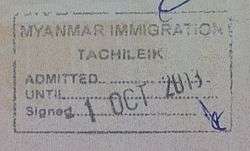
 Exit stamp issued at Tachileik when leaving on the Friendship Bridge. Note that the stamp specifically names Mae Sai as destination.
Exit stamp issued at Tachileik when leaving on the Friendship Bridge. Note that the stamp specifically names Mae Sai as destination.
Nepal
Nepal is one of the few countries which use sticker stamps. Nepalese immigration authorities use separate Arrival and Departure stickers for entry and exit on all types of passports.
 Entry sticker on arriving at Tribhuvan International Airport, Kathmandu.
Entry sticker on arriving at Tribhuvan International Airport, Kathmandu. Exit sticker stamp at Tribhuvan International Airport, Kathmandu.
Exit sticker stamp at Tribhuvan International Airport, Kathmandu.
Philippines
At airports, red ink is used for arrivals/entry and green is used for departure/exit. As a general rule, passports of all travellers regardless of their nationality (including Filipino passport holders), need to be stamped at both entry and exit points. The attending officer also writes down the flight number and stamps the passenger's boarding pass upon departure with the same stamp that is used for departure. The shape and/or designs of the stamps are changed every five to six years.
Saudi Arabia
Saudi entry stamps are in black or blue ink. Entry stamps are in oval shape while exit stamps are rounded rectangular. All dates written on the stamps are in the Hijra calendar, and it is written in Arabic. There is no English on the stamps, except for the "EXIT" or "ENTRY" written on the stamps.
 Passport stamps from the King Abdulaziz International Airport in Jeddah on a Philippine passport.
Passport stamps from the King Abdulaziz International Airport in Jeddah on a Philippine passport.
Singapore
Singapore entry stamps are in blue or black and either rectangular for those entitled to 14 days, rounded rectangular for those entitled to 30 days stay, or hexagonal for those entitled to 90 day stay. Exit stamps are circular and in green. Both depict the date of entry/exit and entry stamps also state the terms of entry and permitted duration of stay.
Both entry and exit stamps do not name the point of entry/exit but indicate them by the use of letters of the alphabet - "A" is used for entry by air, namely through Changi Airport or Seletar Airport; "S" by sea though the Singapore Cruiseship Terminal or Tanah Merah Ferry Terminal; "T" by land via the Tuas Checkpoint; and "W" by land via the Woodlands Checkpoint. The entry stamp has the letter running along the border of the stamp together with a code number while the exit stamp has a single letter marked in the center of the stamp.
 Entry stamp at Changi Airport in an old Thai Passport
Entry stamp at Changi Airport in an old Thai Passport Exit stamp at Changi Airport
Exit stamp at Changi Airport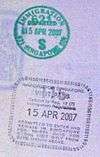 Entry and exit by sea, at the Singapore Cruise Center.
Entry and exit by sea, at the Singapore Cruise Center. Entry stamp into Singapore via Tuas Checkpoint in a Malaysian Passport
Entry stamp into Singapore via Tuas Checkpoint in a Malaysian Passport Exit stamp in a Malaysian Passport for leaving Singapore to Tanjung Kupang in Johor, Malaysia, via the Tuas Checkpoint
Exit stamp in a Malaysian Passport for leaving Singapore to Tanjung Kupang in Johor, Malaysia, via the Tuas Checkpoint Entry stamp at Singapore via Woodlands Train Checkpoint in a Malaysian Passport
Entry stamp at Singapore via Woodlands Train Checkpoint in a Malaysian Passport- Exit stamp in a Malaysian Passport for leaving Singapore to Johor Bahru via Woodlands Train Checkpoint
Sri Lanka
 Entry stamp at Bandaranaike International Airport
Entry stamp at Bandaranaike International Airport Exit stamp at Bandaranaike International Airport
Exit stamp at Bandaranaike International Airport
South Korea
Entry stamp is square shaped and stamped with magenta ink. Exit stamp is round shaped and stamped with cyan ink. Exit stamp is omitted to every passenger since 1 November 2016. Entry stamp is only omitted to Republic of Korea travel document holder since 10 February 2011. Each stamp is only given on one's request.
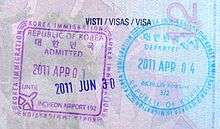 Entry and exit stamps at Incheon International Airport, depicting aircraft.
Entry and exit stamps at Incheon International Airport, depicting aircraft.- Entry and exit stamps at Busan Port, depicting sea vessels.
 An exit stamp at Incheon International Airport in a Republic of Korea passport.
An exit stamp at Incheon International Airport in a Republic of Korea passport.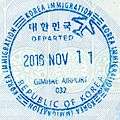 An exit stamp at Gimhae International Airport in a Republic of Korea passport (given upon request).
An exit stamp at Gimhae International Airport in a Republic of Korea passport (given upon request).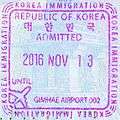 An entry stamp at Gimhae International Airport in a Republic of Korea passport (given upon request).
An entry stamp at Gimhae International Airport in a Republic of Korea passport (given upon request).
Taiwan
A set of new passport stamps was used from February 10, 2013. The Chinese characters on the new stamps are inscribed by Yang-Zi Dong, a famous calligrapher in Taiwan.
 Entry and exit stamps at Kaohsiung International Airport in a U.S. passport.
Entry and exit stamps at Kaohsiung International Airport in a U.S. passport.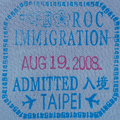 Entry stamp in a passport at Taiwan Taoyuan International Airport, Taiwan.(R.O.C.)
Entry stamp in a passport at Taiwan Taoyuan International Airport, Taiwan.(R.O.C.) Exit stamp in a passport at Taiwan Taoyuan International Airport, Taiwan.(R.O.C.)
Exit stamp in a passport at Taiwan Taoyuan International Airport, Taiwan.(R.O.C.)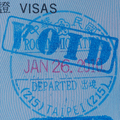 A void exit stamp in a passport at Taiwan Taoyuan International Airport, Taiwan.(R.O.C.)
A void exit stamp in a passport at Taiwan Taoyuan International Airport, Taiwan.(R.O.C.) An entry stamp at Taoyuan International Airport in a Republic of Korea passport.
An entry stamp at Taoyuan International Airport in a Republic of Korea passport. An exit stamp at Taoyuan International Airport in a Republic of Korea passport.
An exit stamp at Taoyuan International Airport in a Republic of Korea passport.
Thailand
Immigration stamps applied by Thailand's Immigration Bureau are stamped on all passports upon arrival at or departure from Thailand. All stamps are made in blue ink. Entry stamps are rectangular and exit stamps are triangular. Stamps bear the date and point of entry/exit, as well as a letter running along the border of the stamp accompanying a code number. Entry stamps for foreigners also state expiry date. From 11 April 2012, an automatic gate system was initiated at Suvarnabhumi Airport to scan certain Thai passports.[4] Therefore, there is no need to stamp on scanned Thai passports.
- Entry and exit stamps at Betong land border crossing on Malaysia–Thailand border.
 Entry and exit stamps at Don Mueang International Airport in an old Thai passport.
Entry and exit stamps at Don Mueang International Airport in an old Thai passport. Entry stamp at Thai–Lao Friendship Bridge in a Thai passport.
Entry stamp at Thai–Lao Friendship Bridge in a Thai passport. Exit stamp at Thai–Lao Friendship Bridge in a Thai passport.
Exit stamp at Thai–Lao Friendship Bridge in a Thai passport.- Entry and exit stamps at Phuket International Airport.
- Entry stamp at Sadao land border crossing on Malaysia–Thailand border.
- Exit stamp at Sadao land border crossing on Malaysia–Thailand border.
- Entry stamp at Satun land border crossing on Malaysia–Thailand border.
- Exit stamp at Satun land border crossing on Malaysia–Thailand border.
- Entry and exit stamps at Suvarnabhumi Airport.
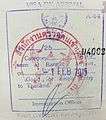 Visa on arrival stamp on a Taiwanese passport.
Visa on arrival stamp on a Taiwanese passport.
Timor-Leste
Timor-Leste uses a full page blue stamp along with a red date entry stamp on entry. Exit stamps are a black oval.
 Passport stamp of the country Timor-Leste
Passport stamp of the country Timor-Leste
United Arab Emirates
The UAE use oval blue stamps on entry, along with a smaller blue rectangular stamp showing the valid length of stay. Exit stamps are a green oval.
- Entry and exit stamps at Abu Dhabi International Airport.
Vietnam
Vietnam passport stamps rectangular and name the point of entry, date of entry and whether the person is exiting or entering the country by using an arrow out of or into an box similar to the Schengen passport stamps. Mode of entry is indicated by an icon and also differentiated by the colour of the stamp - blue for air, red for land crossings. The permitted length of stay is printed with a separate stamp and the final date handwritten.
 Exit stamp from the road border crossing at Moc Bai.
Exit stamp from the road border crossing at Moc Bai.- Entry and exit stamps at Noi Bai International Airport, Hanoi.
- Entry and exit stamps at Tan Son Nhat International Airport, Ho Chi Minh City.
Africa
Egypt
 Egyptian visa with entry and exit stamps from Cairo International Airport.
Egyptian visa with entry and exit stamps from Cairo International Airport.
Ghana
- An entry stamp to Ghana as seen in a U.S. Passport.
- A Ghana exit stamp
Nigeria
 An entry stamp to Nigeria as seen in a Nigerian Passport at Seme Border.
An entry stamp to Nigeria as seen in a Nigerian Passport at Seme Border. A Nigerian exit stamp as seen in a Nigerian Passport at Lagos.
A Nigerian exit stamp as seen in a Nigerian Passport at Lagos.
Morocco
 Passport entry stamp from the port of Tangier, Tanger in French. Shown in a Canadian Passport.
Passport entry stamp from the port of Tangier, Tanger in French. Shown in a Canadian Passport. Exit stamp at the border crossing between Beni-Anzar and Melilla, in a US passport.
Exit stamp at the border crossing between Beni-Anzar and Melilla, in a US passport.
South Africa
 A South African entry stamp as seen in a Nigerian Passport issued for study purposes.
A South African entry stamp as seen in a Nigerian Passport issued for study purposes. An entry stamp to South Africa issued for vacation purposes.
An entry stamp to South Africa issued for vacation purposes. A South African exit stamp at Johannesburg-OR Tambo
A South African exit stamp at Johannesburg-OR Tambo
Swaziland
- Passport stamp from Swaziland
Europe
Schengen Area
| Wikimedia Commons has media related to Schengen Area passport stamps. |
All 26 European countries within the Schengen Area have entry and exit stamps of a uniform design. As of February 2013, at a national level, 11 Schengen countries (Estonia, Finland, Greece, Hungary, Latvia, Lithuania, Malta, Poland, Portugal, Slovakia and Spain)[5][6][7][8][9][10] have developed computer databases recording entries and exits of third-country nationals (i.e. travellers who are not EU, EEA or Swiss citizens) at external border crossing points. However, on a Schengen-wide level, there is no centralised computer database that tracks entries and exits at all of the external border crossing points of the 26 Schengen countries, nor are entry and exit records from national databases shared between countries.[11][12] As a result, law enforcement officials continue to rely on checking passport stamps as the primary way to check that travellers who do not have the right of free movement have not exceeded their length of permitted stay in the Schengen Area.
There are no systematic immigration checks when travelling between Schengen countries (i.e. crossing the internal borders of the Schengen Area). Passport stamps are never issued when travelling between Schengen countries, even when immigration checks between Schengen countries are temporarily re-introduced.[13]
When travelling to/from a non-Schengen country (i.e. crossing the external borders of the Schengen Area), the rules on stamping travel documents are as follows:
| Persons whose travel documents are to be stamped | Persons whose travel documents are not to be stamped |
|---|---|
|
|
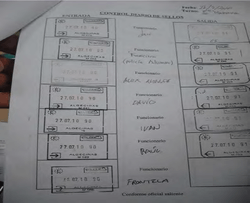
Border officials are required, by law, to stamp the travel documents of third country nationals who do not qualify for one of the exemptions listed in the right hand column, even when border controls have been relaxed.[16] Exceptionally, if stamping a person's travel document would cause serious difficulties (such as political persecution), border officials can instead issue a sheet of paper detailing the person's name, travel document number and entry date and location.[15] However, in practice, border officials do not always stamp the travel documents of travellers as legally required.[17][18] If a person who should have received an entry stamp cannot show one either upon request by a law enforcement officer or upon leaving the Schengen Area to a border official, the officer can presume that the person has been staying illegally in the Schengen Area and can expel him/her, unless the person can demonstrate using credible evidence (such as transport tickets and accommodation receipts) that he/she has not exceeded his/her permitted length of stay in the Schengen Area.[19]
Also, whilst by law persons enjoying the right of freedom of movement are not to receive a passport stamp, in practice, upon request, a stamp may be given - see the gallery below for an example of an entry stamp being issued upon request by an EU citizen. Similarly, although by law heads of state are not to receive a passport stamp, in practice, this is not always followed; when arriving for the 37th G8 summit in Deauville, United States President Barack Obama had his passport stamped at Deauville – Saint-Gatien Airport.[20]
Although, according to EU rules, third country nationals who hold residence permits must not have their travel documents stamped, France nonetheless requires third country nationals holding a visa de long séjour valant titre de séjour (a long-stay visa serving additionally as a residence permit for up to one year) to receive a passport stamp upon their first entry to the Schengen Area as a part of the process to validate the visa as a residence permit; without an entry stamp, the process cannot be completed.[21]
Third-country nationals who otherwise fulfil all the criteria for admission into the Schengen area must not be denied entry for the sole reason that there is no remaining empty space in their travel document to affix a stamp; instead, the stamp should be affixed on a separate sheet of paper.[22]
Entry and exit stamps are applied in black ink, except for the red date stamp and a two-digit security code in the middle. The two-digit security code must be changed at least once a month,[23] although some Schengen countries (such as Greece) change security codes every day.[13] The stamps bear the country abbreviation within a circle of stars in the top left hand corner, the name of the entry/exit border crossing point at the bottom, and an icon in the top right hand corner to denote the mode of entry/exit. Below the name of the border crossing point is an identifying number - a record is kept of the identity of the border officer to whom a given stamp is assigned at any given time.[23] Entry stamps are rectangular and have an arrow into a square, while exit stamps are rectangular with rounded corners and have an arrow out of a square. The stamps do not indicate any duration of stay.
Border guards are required to ensure the secure storage of passport stamps in locked safes between shifts. Border posts are advised to set out clear responsibilities and instructions for the distribution and use of passport stamps.[24]
According to European Commission recommendations and guidelines, stamps should be affixed in travel documents by border officials in the following manner:[18]
- in chronological order
- in a horizontal position
- in a clear and straight manner (i.e. with enough ink and not over the edge of a page)
- the exit stamp should be affixed in the proximity of the entry stamp
- no stamp should be affixed over another stamp or over the machine readable zone of a visa
- if the travel document contains a single-entry Schengen visa, the stamp should be affixed over the edge of the visa, but without affecting the legibility of the conditions and security features of the visa
- if the travel document contains a multiple-entry Schengen visa, the stamp should be affixed on the page facing the one on which the visa is affixed
The obligation imposed by European law on national border authorities to stamp travel documents of certain travellers should not prevent the development of automated border control systems which are then made available to those who are required to have their travel documents stamped when crossing the external border of the Schengen Area. One solution is to dedicate separate lanes to third-country nationals and to have a border guard physically positioned next to the automated border gates used by these lanes who can stamp travel documents where required: this has been adopted by the Finnish Border Guard at the automated border gates in Helsinki Airport, where eligible users (who are required to receive a passport stamp) include holders of Canadian, Japanese, South Korean and United States biometric passports,[25][26][27] and in the Port of Helsinki, where eligible users (who are required to receive a passport stamp) include Russian citizens,[26] as well as by the Portuguese Serviço de Estrangeiros e Fronteiras at the automated border gates in Lisbon Airport where eligible users (who are required to receive a passport stamp) include holders of Angolan and Brazilian passports and holders of diplomatic/service passports). A similar but slightly different solution has been adopted by the Dutch Royal Marechaussee at the Privium iris recognition automated border gates at Amsterdam Schiphol Airport, where eligible users include registered EU/EEA/Swiss citizens, US citizens who are Global Entry members, and all nationals who are holders of diplomatic passports, as well as by the German Federal Police at the ABG Plus iris recognition automated border gates at Frankfurt Airport where eligible users include registered EU/EEA/Swiss citizens and US citizens who are Global Entry members: when eligible third-country nationals use Privium/ABG Plus, after their iris is scanned and verified, a different gate/door/turnstile opens to that for EU/EEA/Swiss citizens and the third-country national user is directed to a lane which leads them to the front of the queue for manual passport checks at immigration desks, where the border guard stamps the user's passport. Another possible solution would be to design the automated border gates to print a paper slip with an entry or exit stamp on it, as well as the user's name and travel document number, whenever the user is a traveller who is subject to the requirement to have his/her travel document stamped.[28]
- Uniform design of Schengen member states' passport stamps
 Entry stamp for air travel, issued at Sandefjord Airport in Norway.
Entry stamp for air travel, issued at Sandefjord Airport in Norway.
(Note that the stamp is in a British passport, hence it was issued on special request.) Entry stamp for rail travel, issued in Nickelsdorf at the Austro-Hungarian border before Hungary joined the Schengen Area.
Entry stamp for rail travel, issued in Nickelsdorf at the Austro-Hungarian border before Hungary joined the Schengen Area. Entry stamp for road travel, issued in Doirani at the Greek-Macedonian border.
Entry stamp for road travel, issued in Doirani at the Greek-Macedonian border.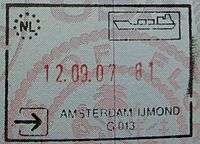 Entry stamp for ferry travel, issued at the port of Amsterdam IJmond in the Netherlands.
Entry stamp for ferry travel, issued at the port of Amsterdam IJmond in the Netherlands. Exit stamp for air travel, issued at Prague Ruzyně Airport in the Czech Republic.
Exit stamp for air travel, issued at Prague Ruzyně Airport in the Czech Republic. Exit stamp for rail travel, issued in Bad Schandau at the Czech-German border before the Czech Republic joined the Schengen Area.
Exit stamp for rail travel, issued in Bad Schandau at the Czech-German border before the Czech Republic joined the Schengen Area. Exit stamp for road travel, issued in Korczowa at the Polish-Ukrainian border.
Exit stamp for road travel, issued in Korczowa at the Polish-Ukrainian border.
| Passport stamps by Schengen member state | ||||||||||||||||||||||||||||||||||||||||||||||||||
|---|---|---|---|---|---|---|---|---|---|---|---|---|---|---|---|---|---|---|---|---|---|---|---|---|---|---|---|---|---|---|---|---|---|---|---|---|---|---|---|---|---|---|---|---|---|---|---|---|---|---|
|
Albania
 Entry stamp for air travel issued at Tirana International Airport Nënë Tereza.
Entry stamp for air travel issued at Tirana International Airport Nënë Tereza. Exit Stamp for ferry travel
Exit Stamp for ferry travel
Andorra
Entry from France or Spain requires no formalities. However a souvenir stamp is issued on request at the border.
Belarus
Belarus is a member of the Union State of Russia and Belarus but, like Russia, still has its own passport stamps. The passport stamp has the state's name in the Belorusian language: Republic of Belarus, date and name of the checkpoint.
- Entry stamp in Brest (January 2000).
Bulgaria
Although Bulgaria is a European Union member state, it has not yet joined the Schengen Area. Nonetheless, it has adopted the common Schengen design for passport stamps.
| Wikimedia Commons has media related to Passport stamps of Bulgaria. |

 Exit stamp for air travel issued at Sofia Airport.
Exit stamp for air travel issued at Sofia Airport.
Croatia
After joining the European Union on 1 July 2013, Croatia adopted the common Schengen design for passport stamps, even though Croatia is still not a member of the Schengen passport-free area.
| Wikimedia Commons has media related to Passport stamps of Croatia. |
 Entry stamp for rail travel, issued at Savski Marof.
Entry stamp for rail travel, issued at Savski Marof. Exit stamp for rail travel, issued at Savski Marof.
Exit stamp for rail travel, issued at Savski Marof. Exit stamp for road travel, issued in Terezino Polje.
Exit stamp for road travel, issued in Terezino Polje.
Cyprus
Although Cyprus is a European Union member state, it has not yet joined the Schengen Area. Nonetheless, it has adopted the common Schengen design for passport stamps.
 Entry stamp for air travel issued in Paphos International Airport.
Entry stamp for air travel issued in Paphos International Airport. Exit stamp for air travel issued in Paphos International Airport.
Exit stamp for air travel issued in Paphos International Airport.
Czech Republic
- Entry stamp for vehicle travel at Náchod in January 2000.
Germany
Refused entries (Zurückweisung) are stamped in the passports, too.
| Wikimedia Commons has media related to Passport stamps of Germany. |
 Entry at airport
Entry at airport Entry by car
Entry by car Exit by rail
Exit by rail Pre-Schengen German passport stamp
Pre-Schengen German passport stamp
Ireland
 Arrival stamp for air travel issued at Dublin Airport.
Arrival stamp for air travel issued at Dublin Airport.
Kosovo
- Entry and Exit stamps from Pristina International Airport Adem Jashari.
Monaco
The border with France is completely open. However, a souvenir stamp is given on request at the tourist office.
Poland
- Entry for transit stamp at Kudowa-Zdrój (border with Czech Rep.), February 2000
Romania
Romania is not currently a member of the Schengen Area, however, being in the European Union since 2007, Romanian entry and exit stamps have been harmonised with the format of the stamps issued by Schengen states.
| Wikimedia Commons has media related to Passport stamps of Romania. |
- Exit stamp for train travel, issued at Curtici on the Schengen border with Hungary.
- Entry stamp for air travel, issued at Henri Coandă International Airport.
 Exit stamp at Henri Coandă International Airport in a U.S. passport.
Exit stamp at Henri Coandă International Airport in a U.S. passport.- Entry stamp for air travel, issued at Timisoara Airport.
- Exit stamp for road travel, issued at Turnu on the border with Hungary.
- Exit stamp for air travel, issued at Timisoara Airport shortly before the Entry of Romania in the EU.
Russia
| Wikimedia Commons has media related to Passport stamps of Russia. |
Entry and exit stamps are placed in passports regardless of citizenship; Russian passports are stamped as well as foreign ones, except the Internal Passports, with which Russian citizens may travel to a few countries of the CIS. The stamp shows the name of the country (КПП below the country name stands for checkpoint - контрольно-пропускной пункт), the date, the name of the checkpoint and the personal code of the immigration official applying the stamp. Stamp colours and series (the last number following the date) change every time in few years, currently the colour of the stamps is blue of 6 series, but it can be orange or crimson as well. Entry or exit is designated by a direction of an angle bracket in the stamp: if it points to the right, that denotes exit. Ukrainian passport stamps are identical to the Russian stamps and have the same information. They can be stamped in green, red, orange, blue, pink and sometimes black ink.
- Exit (left) and entry (right) stamps at St. Petersburg Pulkovo airport (1995-1998) in a Soviet passport (Russian Federation citizenship).
- Exit stamp for vehicle travel at Torfyanovka (border with Finland) (2005).
 Exit (left) and entry stamps issued at Moscow Sheremetyevo Airport. Circled number "2" indicates travelling with a child using parent's passport (2006).
Exit (left) and entry stamps issued at Moscow Sheremetyevo Airport. Circled number "2" indicates travelling with a child using parent's passport (2006). Entry Stamp (right) and Exit Stamp (left) for boat travel issued at Saint Petersburg Port in an American passport (2006).
Entry Stamp (right) and Exit Stamp (left) for boat travel issued at Saint Petersburg Port in an American passport (2006). Exit stamp for air travel issued at Moscow Sheremetyevo Airport (2009).
Exit stamp for air travel issued at Moscow Sheremetyevo Airport (2009).- New design exit stamp for air travel issued at St. Petersburg Pulkovo airport (2016).
 Right: entry stamp for rail travel issued between Vyborg and St Petersburg. Left: exit stamp for rail travel issued at Aksarayskaya. Placed on a transit visa in a Swedish passport (2016)
Right: entry stamp for rail travel issued between Vyborg and St Petersburg. Left: exit stamp for rail travel issued at Aksarayskaya. Placed on a transit visa in a Swedish passport (2016)
San Marino

Even though there is an open border agreement with Italy, visitors can have their passport stamped by the San Marino authority at the passport office in the city centre for a small fee.
Serbia
 entry stamp for road travel, issued in Kelebia
entry stamp for road travel, issued in Kelebia
Switzerland
Although Switzerland is not a European Union member state, it is part of the Schengen Area and so it has adopted the common Schengen design for passport stamps.
| Wikimedia Commons has media related to Passport stamps of Switzerland. |
- Entry stamp for air travel, issued at Geneva Airport before the entry of Switzerland in the Schengen zone.
- Entry stamp for air travel, issued at Zurich Airport after the entry of Switzerland in the Schengen zone.
Turkey
 Entry and exit stamps from Istanbul Atatürk Airport
Entry and exit stamps from Istanbul Atatürk Airport
Ukraine
Ukrainian passport stamps resemble Russian stamps. They bear the country's name, mode of travel (ship, train, vehicle, plane), code of the immigration officer, chevron (facing to the right for entry, to the left for exit), date, serial code (probably periodic), name of the checkpoint and its code. All are written in the Ukrainian language.
- Entry stamp from Odessa international airport in an old Israeli passport (2013)
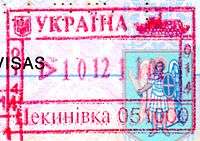
 Exit stamp from the Bolgan checkpoint (border with Moldova) (2009)
Exit stamp from the Bolgan checkpoint (border with Moldova) (2009) Exit stamp from the Krakovetz checkpoint (old style) in Kazakh passport (1999)
Exit stamp from the Krakovetz checkpoint (old style) in Kazakh passport (1999)
United Kingdom
The UK Border Force only stamps the travel documents of travellers entering the UK from outside the Common Travel Area who do not have the right of abode in the UK or are not exercising the right to freedom of movement.
Travellers arriving in the UK from the Channel Islands, Ireland and the Isle of Man are not subject to immigration checks as they are travelling within the Common Travel Area. However, travel from the European mainland (e.g. France) is still subject to immigration checks, as the UK is not part of the Schengen Area, even though it is a European Union member state.
There are no routine exit checks when departing from the UK by air, however exit checks are done when leaving through a sea port or the Channel Tunnel, In this case, travel documents are not stamped.
The following table shows which travellers arriving in the UK from outside the Common Travel Area receive a passport stamp:
| Category of persons | Travel document to be stamped on arrival in the UK | |
|---|---|---|
| British and Commonwealth citizens with the right of abode | No | |
| EU, EEA and Swiss citizens exercising the right of freedom of movement | No | |
| Family members of EU, EEA and Swiss citizens with an EEA Family Permit (first arrival in the UK)[29] | Yes | |
| Family members of EU, EEA and Swiss citizens with an EEA Family Permit (subsequent arrivals in the UK) | Optional | |
| Family members of EU, EEA and Swiss citizens with a residence card | No | |
| All other persons not covered in a category above | Yes | |
UK passport stamps are in black ink and bear the name of the entry point, as well as the immigration officer's identification number. If the traveller is a non-visa national who does not hold entry clearance, the passport stamp includes the conditions of the leave to enter granted.
If the traveller is the holder of visa/entry clearance or an EEA Family Permit or a person exempt from immigration control (e.g. a diplomat), he/she receives an open date passport stamp (i.e. a stamp that does not contain any leave conditions).[30] Moreover, this entry passport stamp is stamped on the right edge of the visa/entry clearance during the traveller's first entry to indicate that the document has been used even if the document is valid for multiple entries.
| Wikimedia Commons has media related to Passport stamps of the United Kingdom. |
 Passport stamp with 6 months' leave to enter issued at Heathrow Airport to a non-visa national.
Passport stamp with 6 months' leave to enter issued at Heathrow Airport to a non-visa national. Passport stamp with 6 months' leave to enter issued at the Channel Tunnel to a non-visa national.
Passport stamp with 6 months' leave to enter issued at the Channel Tunnel to a non-visa national.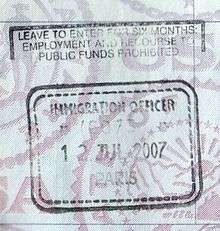 Passport stamp with 6 months' leave to enter issued at the juxtaposed controls at Paris Gare du Nord to a non-visa national.
Passport stamp with 6 months' leave to enter issued at the juxtaposed controls at Paris Gare du Nord to a non-visa national. Passport stamp with 6 months' leave to enter issued at Heathrow Airport in London to a visa national from Russia. No restrictions, thus, allowed to work.
Passport stamp with 6 months' leave to enter issued at Heathrow Airport in London to a visa national from Russia. No restrictions, thus, allowed to work.- Old style passport stamp issued at Durham Tees Valley Airport to a non-visa national with leave conditions laid out.
North America
Canada
- Entry stamp at Lewiston–Queenston Bridge, Ontario.
 Entry stamp at Montréal-Pierre Elliott Trudeau International Airport.
Entry stamp at Montréal-Pierre Elliott Trudeau International Airport.- Entry stamp at Rainbow Bridge, Ontario on a Colombian passport.
 Entry Stamp issued by Canada Immigration at Toronto-Lester B. Pearson International Airport This stamp is used by immigration officers for passengers who need secondary immigration checks.
Entry Stamp issued by Canada Immigration at Toronto-Lester B. Pearson International Airport This stamp is used by immigration officers for passengers who need secondary immigration checks. Entry stamp at Dorval International Airport in Montreal, which is Pierre Elliott Trudeau's airport former name. This stamp is used by passport control officers at Canada's international airports.
Entry stamp at Dorval International Airport in Montreal, which is Pierre Elliott Trudeau's airport former name. This stamp is used by passport control officers at Canada's international airports.
Cuba
 Entry and Exit stamps from Cayo Coco Airport.
Entry and Exit stamps from Cayo Coco Airport.
French overseas departments and collectivities
When arriving in and departing from the French overseas departments of Guadeloupe and Martinique and the French overseas collectivities of Saint Barthélemy, Saint Martin and Saint Pierre and Miquelon, French Border Police officers stamp travellers' travel documents according to the following rules:[31][32]
| Persons whose travel documents are to be stamped | Persons whose travel documents are not to be stamped |
|---|---|
|
|
Whilst the rules for stamping travel documents of travellers arriving in and departing from the French overseas departments/collectivities mentioned above are based upon the rules which apply in metropolitan France and the Schengen Area (see the section above), important differences exist between the two sets of rules. For example, when crossing the external border of the Schengen Area, only family members of EU/EEA/Swiss citizens who hold a residence card issued under Article 10 of Directive 2004/38/EC and who are accompanying or joining their EU, EEA and Swiss citizen family member exercising the right of freedom of movement are exempt from having their travel documents stamped, whereas in the French overseas departments/collectivities mentioned above, more generous rules apply — when entering/leaving Guadeloupe/Martinique/Saint Pierre and Miquelon, a family member of an EU/EEA/Swiss citizen who holds a residence card issued by an EU/EEA member state or Switzerland under Article 10 of Directive 2004/38/EC is exempt from having his/her travel document stamped regardless of whether he/she is accompanying/joining his/her EU/EEA/Swiss citizen family member; when entering/leaving Saint Barthélemy and Saint Martin, a family member of an EU/EEA/Swiss citizen who holds a residence card issued by an EU/EEA member state or Switzerland is exempt from having his/her travel document stamped regardless of whether he/she is accompanying/joining his/her EU/EEA/Swiss citizen family member and regardless of whether the residence card was issued under Article 10 of Directive 2004/38/EC. Another example relates to third-country nationals who hold a residence permit issued by a Schengen member state — when crossing the external border of the Schengen Area, his/her travel document should not be stamped, but when entering/leaving a French overseas department/collectivity, whilst he/she is not required to hold a visa for a short stay not exceeding 90 days in a 180-day period,[33] his/her travel document will be stamped upon entry and exit.
Another exception applies in the case of the French overseas collectivity of Saint Martin —- travellers who in principle are subject to the obligation to have their travel documents stamped but who have cleared immigration control in Sint Marteen will not have their passport stamped when they enter/leave the French side of Saint Martin.[32]
The design of passport stamps issued in the French overseas departments/collectivities differs from those issued in metropolitan France/the Schengen Area. Entry stamps issued in French overseas departments/collectivities are rectangular, whilst exit stamps are hexagonal.
 Entry stamp at the port of Pointe-à-Pitre (Guadeloupe) in a Swedish passport.
Entry stamp at the port of Pointe-à-Pitre (Guadeloupe) in a Swedish passport. Exit stamp at Pointe-à-Pitre International Airport (Guadeloupe) in a Swedish passport
Exit stamp at Pointe-à-Pitre International Airport (Guadeloupe) in a Swedish passport Entry (top) and exit (bottom) stamps at the ferry dock in Saint-Pierre (Martinique) in a Swedish passport. Currently Saint-Pierre uses stamps from the port of Fort-de-France.
Entry (top) and exit (bottom) stamps at the ferry dock in Saint-Pierre (Martinique) in a Swedish passport. Currently Saint-Pierre uses stamps from the port of Fort-de-France. Entry stamp in Saint Barthélemy.
Entry stamp in Saint Barthélemy. Entry stamp at Saint-Pierre
Entry stamp at Saint-Pierre
Haiti
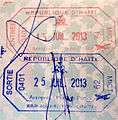 Entry and exit stamps from Toussaint Louverture International Airport, Port-au-Prince.
Entry and exit stamps from Toussaint Louverture International Airport, Port-au-Prince.
Mexico
 Entry stamp from Tijuana, Baja California land border crossing.
Entry stamp from Tijuana, Baja California land border crossing.
United States
 Entry stamp at San Francisco International Airport.
Entry stamp at San Francisco International Airport. USA stamp at Champlain–St. Bernard de Lacolle Border Crossing.
USA stamp at Champlain–St. Bernard de Lacolle Border Crossing. American stamp from John F. Kennedy International Airport in a U.S. Passport.
American stamp from John F. Kennedy International Airport in a U.S. Passport. American stamp in a U.S. Passport.
American stamp in a U.S. Passport.
The actual deadline to leave the U.S. for those admitted on a non-immigrant status is written at the bottom of the stamp, placed in the passport (when entering by air or sea) or on a green I-94W form stapled into the passport,
With the introduction of Automated Passport Control (APC), entries are not always stamped into passports of travelers using the kiosks (especially US passports). There are custom slips printed out from the machine, which are stamped by immigration and then handed over to customs.
Oceania
Australia
The Australian government no longer provides a Port and Date Stamp in travelers’ passports on departure from Australia without a request. If travelers need exit stamps in their passports, they must ask the Customs and Border Protection officer when they depart Australia. Entry stamps are still given to non-Australian passport holders and on request for Australian passport holders.
Travellers using SmartGate (available to bearers aged 16 years or older who hold an ePassport issued by Australia, Canada, Ireland, New Zealand, Hong Kong, Macau, PR China, Singapore, Switzerland, Taiwan, United Kingdom or the United States of America.) will not have their passports stamped on arrival in Australia.
(Airline crew who meet the eligibility requirements can choose to use arrivals SmartGate rather than being manually processed through the crew lane but Australian and New Zealand ePassport holders travelling on military orders are not eligible to use arrivals SmartGate.)
- Entry stamp at Coolangatta Airport
- Exit stamp at Coolangatta Airport
Fiji
 Entry stamp at Nadi International Airport in Fiji.
Entry stamp at Nadi International Airport in Fiji. Exit stamp at Nadi International Airport.
Exit stamp at Nadi International Airport.
French overseas territories (French Polynesia, New Caledonia, Wallis and Futuna)
When arriving in and departing from the French overseas territories of French Polynesia, New Caledonia and Wallis and Futuna, French Border Police officers stamp travellers' travel documents according to the following rules:[34][35][36][37]
| Persons whose travel documents are to be stamped | Persons whose travel documents are not to be stamped |
|---|---|
|
|
When travelling between the French overseas territories situated in the Pacific Ocean (for example, when travelling directly by plane from New Caledonia to French Polynesia), unless qualifying for one of the exemptions in the right hand column in the table above, a traveller will receive a passport stamp in his/her travel document upon departure from New Caledonia and another stamp upon arrival in French Polynesia.
Whilst the rules for stamping travel documents of travellers arriving in and departing from the French overseas territories in the Pacific Ocean are based upon the rules which apply in metropolitan France and the Schengen Area (see the section above), important differences exist between the two sets of rules. For example, when crossing the external border of the Schengen Area, only family members of EU/EEA/Swiss citizens who hold a residence card issued under Article 10 of Directive 2004/38/EC and who are accompanying or joining their EU, EEA and Swiss citizen family member exercising the right of freedom of movement are exempt from having their travel documents stamped, whereas in the French overseas territories in the Pacific, more generous rules apply — a family member of an EU/EEA/Swiss citizen who holds a residence permit issued by an EU/EEA member state or Switzerland is exempt from having his/her travel document stamped regardless of whether he/she is accompanying/joining his/her EU/EEA/Swiss citizen family member and regardless of whether his/her residence permit was issued under Article 10 of Directive 2004/38/EC. Another example relates to third-country nationals who hold a residence permit issued by a Schengen member state - when crossing the external border of the Schengen Area, his/her travel document should not be stamped, but when entering/leaving a French overseas territory in the Pacific, whilst he/she is not required to hold a visa for a short stay not exceeding 90 days in a 180-day period,[33] his/her travel document will be stamped upon entry and exit.
The design of passport stamps issued in the French overseas territories in the Pacific differs from those issued in metropolitan France/the Schengen Area. Entry stamps issued in French overseas territories in the Pacific are rectangular, whilst exit stamps are hexagonal.
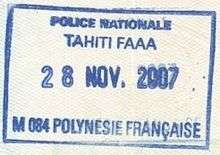 Entry stamp at Fa'a'ā International Airport in French Polynesia.
Entry stamp at Fa'a'ā International Airport in French Polynesia. Exit stamp at Fa'a'ā International Airport in French Polynesia.
Exit stamp at Fa'a'ā International Airport in French Polynesia. Entry stamp at La Tontouta International Airport in New Caledonia.
Entry stamp at La Tontouta International Airport in New Caledonia. Exit stamp at La Tontouta International Airport in New Caledonia.
Exit stamp at La Tontouta International Airport in New Caledonia. Older style exit stamp at La Tontouta International Airport in New Caledonia.
Older style exit stamp at La Tontouta International Airport in New Caledonia.
New Zealand
On arrival in New Zealand, travellers who are neither New Zealand nor Australian citizens or permanent residents who are granted entry into the country will receive a 'Visitor Visa' rectangular stamp in their travel document. New Zealand and Australian permanent residents will receive a 'Resident Visa' red stamp in their travel document. These stamps were formerly known as Visitor and Resident Permits.
New Zealand and Australian citizens do not have their passports stamped on arrival in New Zealand unless specifically requested.
Travellers using SmartGate (available to holders of a New Zealand, Australian, United Kingdom or United States ePassport aged 16 years or over) will not have their passports stamped on arrival in New Zealand.
For all travellers, passports are not stamped on departure from New Zealand (regardless of nationality, and whether using an immigration desk or SmartGate.
 General Entry stamp (given upon request to NZ/Australian passport holders)
General Entry stamp (given upon request to NZ/Australian passport holders) Visitors Visa Entry stamp (for all non-NZ/Australian passport holders without residency in either country)
Visitors Visa Entry stamp (for all non-NZ/Australian passport holders without residency in either country) Resident Visa Entry Stamp (non-NZ/Australian Passport Holder - but with Residency in either country)
Resident Visa Entry Stamp (non-NZ/Australian Passport Holder - but with Residency in either country)
South America
Argentina
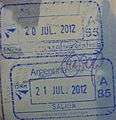 Entry and exit stamps from the Argentina-Brazil border at Puerto Iguazu. Shown here in an U.S. Passport.
Entry and exit stamps from the Argentina-Brazil border at Puerto Iguazu. Shown here in an U.S. Passport.
Brazil
When a holder of a Brazilian Passport enters or exits Brazil they will not receive a passport stamp. However, other nationals will go through customs and receive a stamp for both entry and exit. When entering Brazil by car from another country such as Argentina or Paraguay, few people go through customs and thus rarely receive stamps in their passport.
 Brazilian entry and exit stamps in a US Passport, opposite from the visa. Near a French and American stamp.
Brazilian entry and exit stamps in a US Passport, opposite from the visa. Near a French and American stamp. Brazilian entry stamp in an US passport.
Brazilian entry stamp in an US passport. Brazilian exit stamp in an US passport.
Brazilian exit stamp in an US passport. Entry and exit stamps, issued at São Paulo Airport.
Entry and exit stamps, issued at São Paulo Airport.
Chile
 Chilean entry stamp in a New Zealand passport, issued by the PDIat Santiago Airport.
Chilean entry stamp in a New Zealand passport, issued by the PDIat Santiago Airport. Chilean exit stamp in a New Zealand passport, issued by the PDI at the Paseo los Liberadores border crossing.
Chilean exit stamp in a New Zealand passport, issued by the PDI at the Paseo los Liberadores border crossing.
Colombia
 Entry stamp from El Dorado Airport
Entry stamp from El Dorado Airport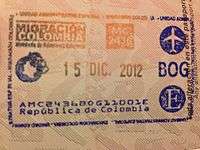 Exit stamp from El Dorado Airport
Exit stamp from El Dorado Airport Exit tax exemption stamp issued by the Aeronautica Civil at El Dorado Airport
Exit tax exemption stamp issued by the Aeronautica Civil at El Dorado Airport
Peru
 Peruvian entry stamp in a New Zealand passport, issued at Lima Airport. Part of a UK entry stamp is visible in the top part.
Peruvian entry stamp in a New Zealand passport, issued at Lima Airport. Part of a UK entry stamp is visible in the top part. Peruvian exit stamp in a New Zealand passport, issued at Lima Airport. Part of a UK entry stamp is visible in the bottom part, as is part of a Chilean stamp in the right.
Peruvian exit stamp in a New Zealand passport, issued at Lima Airport. Part of a UK entry stamp is visible in the bottom part, as is part of a Chilean stamp in the right.
Venezuela
 Entry stamp to Santiago Mariño Intl. Airport; Margarita Island, Venezuela
Entry stamp to Santiago Mariño Intl. Airport; Margarita Island, Venezuela Exit stamp Simón Bolívar Intl. Airport; Caracas, Venezuela
Exit stamp Simón Bolívar Intl. Airport; Caracas, Venezuela
Countries not issuing exit immigration stamps
In some countries, there is no formal control of travel documents upon exit. Consequently, exit stamps are not placed in passports. Exit may be recorded by immigration authorities via information provided to them by carriers when the passenger departs from the country.
No exit control
-
 USA
USA -
 Canada
Canada -
 Mexico
Mexico -
 Bahamas
Bahamas -
 Ireland
Ireland -
 United Kingdom (by air) [38]
United Kingdom (by air) [38]
Formal exit control without passport stamping
-
 United Kingdom (sea ports and channel tunnel) [39]
United Kingdom (sea ports and channel tunnel) [39]  New Zealand
New Zealand Australia[40]
Australia[40] Hong Kong
Hong Kong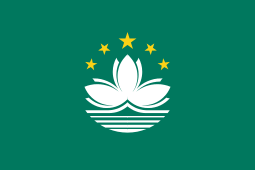 Macau
Macau South Korea (since 1 November 2016)
South Korea (since 1 November 2016) Panama (only at Panamanian airports; different entry and exit stamps are made at the checkpoint with Costa Rica)
Panama (only at Panamanian airports; different entry and exit stamps are made at the checkpoint with Costa Rica)
However, in some of these countries, a departure card is collected.
See also
Notes
- ↑ Immigration Department. "Non-stamping Immigration Clearance Arrangement for Visitors (with effect from 19 March 2013)". Retrieved 15 April 2013.
- ↑ Tens of thousands of hours can be saved by non-stamping immigration clearance
- ↑ "Tanjong Pagar: Talks 'break down'", New Straits Times, pp. 1, 7, 31 July 1998
- ↑ "Automatic gates to ease congestion at Suvarnabhumi Airport". Bangkok. MCOT. 21 March 2012.
- ↑ Proposal for a Regulation of the European Parliament and of the Council establishing an Entry/Exit System (EES) to register entry and exit data of third country nationals crossing the external borders of the Member States of the European Union, pg. 2
- ↑ Communication from the European Commission to the European Parliament and the Council: Communication from the Commission to the European Parliament and the Council, pg. 6
- ↑ Current state of play in relation to innovated border management in the EU
- ↑ Council of the European Union: Questionnaire on the possible creation of a system of electronic recording of entries and exits of third country nationals in the Schengen area
- ↑ Council of the European Union: Questionnaire on the possible creation of a system of electronic recording of entries and exits of third country nationals in the Schengen area (Replies from Bulgaria, France, Iceland, Italy, Norway and Portugal)
- ↑ Council of the European Union: Questionnaire on the possible creation of a system of electronic recording of entries and exits of third country nationals in the Schengen area (Reply from Greece)
- ↑ Communication from the Commission to the European Parliament, the Council, the European Economic and Social Committee and the Committee of the Regions - Preparing the next steps in border management in the European Union, p.5.
- ↑ Note that the European Commission is planning to introduce a Schengen-wide Entry/Exit System (EES) in 2015 that automatically registers the entries and exits of third country nationals.
- 1 2 Report from the Commission to the European Parliament and the Council on the operation of the provisions on stamping of the travel documents of third-country nationals in accordance with Articles 10 and 11 of Regulation (EC) No 562/2006, p. 9
- ↑ Report from the Commission to the European Parliament and the Council on the operation of the provisions on stamping of the travel documents of third-country nationals in accordance with Articles 10 and 11 of Regulation (EC) No 562/2006 (COM (2009) 489, p. 7)
- 1 2 Regulation (EC) No 562/2006, Article 10(3)
- ↑ Regulation (EC) No 562/2006, Article 8(3)
- ↑ US Department of State: Schengen Fact Sheet
- 1 2 Report from the Commission to the European Parliament and the Council on the operation of the provisions on stamping of the travel documents of third-country nationals in accordance with Articles 10 and 11 of Regulation (EC) No 562/2006, p. 5
- ↑ Regulation (EC) No 562/2006, Article 11)
- ↑ Le directeur régional des douanes suspendu Archived June 6, 2011, at the Wayback Machine.
- ↑ http://vosdroits.service-public.fr/particuliers/F39.xhtml
- ↑ Article 4.5 of the Practical Handbook for Border Guards (C (2006) 5186)
- 1 2 Regulation (EC) No 562/2006, Annex IV
- ↑ Schengen Catalogue: External borders control recommendations and best practices
- ↑ http://cwtjet.com/yahoo_site_admin/assets/docs/Automated_Border_Control_Gates.17161248.pdf
- 1 2 http://www.raja.fi/facts/news_from_the_border_guard/1/0/expanded_use_of_automated_border_control_gates_at_the_west_terminal_54569
- ↑ http://frontex.europa.eu/assets/Images_News/ABC_Conference_Report.pdf
- ↑ Art 10(3) of Regulation (EC) No 562/2005 recognises that an entry or exit stamp may be recorded on a sheet of paper indicating the traveller's name and travel document number (rather than inside the traveller's travel document) where stamping the travel document would cause 'serious difficulties' for the traveller. It could be argued that at a particular border crossing point the state of facilities are such that to deny travellers subject to the stamping obligation access to automated border gates and to require them to be processed manually by border guards would constitute 'serious difficulties' for such persons.
- ↑ UK Border Force Operations Manual: EEA Nationals & their family members
- ↑ UK Border Force Operations Manual: Persons exempt from control
- ↑ Arrêté du 26 juillet 2011 relatif aux documents et visas exigés pour l'entrée des étrangers sur le territoire de la Guadeloupe, la Guyane, la Martinique, La Réunion et de la collectivité de Saint-Pierre-et-Miquelon (Annexe I)
- 1 2 Arrêté du 18 avril 2012 relatif aux documents et visas exigés pour l'entrée des étrangers sur le territoire des collectivités de Saint-Barthélemy et de Saint-Martin
- 1 2 http://www.diplomatie.gouv.fr/en/coming-to-france/getting-a-visa/article/foreign-nationals-holding-ordinary
- ↑ Arrêté du 29 décembre 2011 relatif aux documents et visas exigés pour l'entrée des étrangers sur le territoire de la Polynésie française (Annexe I)
- ↑ http://www.polynesie-francaise.pref.gouv.fr/Les-services-de-l-Etat/Securite/La-Police-aux-frontieres
- ↑ Arrêté du 22 juillet 2011 relatif aux documents et visas exigés pour l'entrée des étrangers sur le territoire de la Nouvelle-Calédonie (Annexe I)
- ↑ Arrêté du 26 juillet 2011 relatif aux documents et visas exigés pour l'entrée des étrangers sur le territoire des îles Wallis et Futuna (Annexe I)
- ↑
- ↑ "Passport exit checks begin at UK ports and borders". BBC. Retrieved 12 June 2015.
- ↑ "departing or arriving". Australian Customs and Border Protection Service. Australian Government. Retrieved 19 April 2015.
References
- Report from the Commission to the European Parliament and the Council on the operation of the provisions on stamping of the travel documents of third-country nationals in accordance with Articles 10 and 11 of Regulation (EC) No 562/2006 establishing a Community Code on the rules governing the movement of persons across borders (Schengen Borders Code). European Commission. 2009. Retrieved 2012-06-26.
- Regulation (EC) No 562/2006 of the European Parliament and of the Council of 15 March 2006 establishing a Community Code on the rules governing the movement of persons across borders (Schengen Borders Code)
External links
- PassportStamp A site for recording passport stamp visits
- Passport stamps from the whole world - 181 countries, 748 scans
